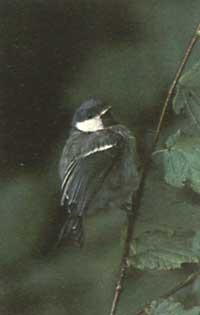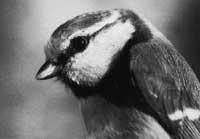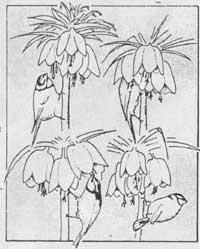Amilotx blue, breeding
1993/12/01 Aihartza, Joxerra Iturria: Elhuyar aldizkaria
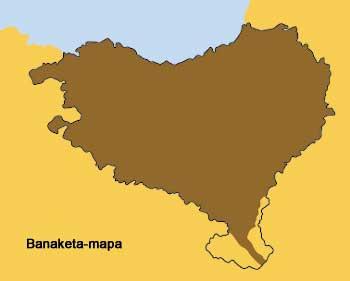
There are few birds that look as beautiful and striking as the blue amilotx (Parus caeruleus) in our territory. Jumping between the branches of sturdy oak, their heads, fins and blue tails, and the chest and yellow belly present a spectacular contrast. This small bird between 11 and 12 cm long, on the other hand, is very intense and cheerful in the form of being, and because of its scarce fear of the human being, often offers us the possibility to see it closely. In these cases, we will discover that it has a clear white face surrounded by black necklaces and a marked black footprint that takes you through the eyes to the blue nape, while we can enjoy a cheerful, shameful and versatile song that opens the birds to the four winds.
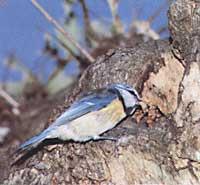
Although it sometimes appears as brave and combative as the txantxangorri, the blue amilotx, and as it happens in other forest species, are quite a few gregarious birds when they are not in heat, and in autumn or winter we will often see them with their motorized amilotx, their “cousins”, their different rattles, their ticks and other groups of more than one species. This behavior is considered a tool to improve the means of defense of these animals. And in large groups there will be more eyes to see enemies or prey.
Blue amilotx is a food insectivore. The black, conical and short beak is an excellent tool for this work, in which it develops on the ends of the horns, in spectacular acrobatics, or striking the bark of the trunk with the beak, in search of the herbs, spiders, vegetable leaves and other invertebrates or their larvae. In addition, and like most other insectivores, from autumn also feeds on fruits and seeds, with the aim of completing their diet in the cold seasons in which invertebrates are so scarce.
All living beings, however, have something that attracts us more attention than the rest, and the blue amilotx surprises us especially when it comes to making offspring. And this beautiful bird is a great player.
In early April the couple has already been formed and the territory where the nest will be built has been selected. From that moment on, the division of labor is evident within the couple: the male will become totally territorialist and will take charge of driving all possible competitors from their territory, while the female will begin the construction of the nest. In nidification, however, the first work will be to find an appropriate place, for which the blue amilotx, which is a troglodyte bird, seeks some kind of hole. In these cases it prefers the holes, openings and patches that usually appear in oaks, chestnut trees or other old trees, but if it does not find them, nest boxes, muretes, etc. you can use them.
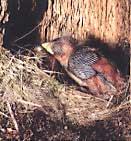
Once the most suitable “house” is found, the female prepares to fix what will be the nest with mosses, herbs, spiders and other materials. The last “touch” will be to enjoy the nest bed with feather and hair. But the real effort of the Blue Amilotx will come after all of them.
Once the nest is prepared, the female begins its laying, and in the following days will lay between 8 and 12 white eggs painted red, whose incubation will last between 13 and 16 days. And this work involves a huge energy expenditure for the female: the weight of each egg is usually 1´3 g, and as it lays 11 eggs per txitada, this means a 14´3 g laying. But the weight of the female is only about 11 g. Therefore, in the case of blue amilotx, the ratio between the eggs of each laying and the weight of the female is 130%, this being the highest of all European birds.
In order to carry it out, at the setting, the female needs an approximate weight of 15 g: 15 g = normal weight (11 g) + weight of one egg (1´3 g) + reservoirs for the following eggs. That, of course, demands a lot of huge food, and that is the work of the male at this time: satisfy the unfinished energy demand of the female.
And then it is not a joke: all the eggs after laying have to drown, and to drown 11 eggs you have to burn much more energy than when the amount is smaller. On the other hand, after the birth of the chickens, they will remain in the nest another 16-21 days, during which the parents will feed them.
But this work does not seem exaggerated for the blue amilotx, and in the spring, with one, with one, two chitazos are made!
However, as in most cases in nature, this proliferative behavior is not optional but accidental. The annual survival rate of adult blue amilotx is only 30%, with an average survival of one year. Therefore, in the case of this single birthing (and following the rule of all species of high mortality), the survival of the population depends on a high fertility (see Table 1). And consequently, this work focuses all its efforts.
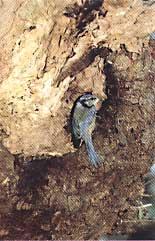
Consequently, the Blue Amilotx is a very widespread species that is found practically in Europe (bordered to the east with Urales and Persia), to the northwest and to the east of Africa. Its residence is usually relatively closed forests and groves, preferring those of leafy to those of conifers. Despite its presence in the Basque Country, it is in the Atlantic oak forests where one of the dominant species predominates, but it is also easy to find it in chestnuts and mixed forests. In the holm oaks and quejigales, on the other hand, it is more scarce and in the beech and beech, although in the latter it has been possible to see up to the altitudes of 1.650 m.
Due to its forest character, in the area of the Ribera is reduced due to deforestation of the area, and in this area only visible in the basements of the river margins, better preserved, and in the pine forests of the Bardenas. On the contrary, and due to the irreverent behavior of this beautiful bird, in the temperate regions we can often see it in the gardens and parks of our villages, without fear of living near humans.
Technical data sheet AMILOTX URDINAEspeciie:Parus caeruleusFamily:
Order:
Passersby Class:
Mean Avifauna
of Burnt EggWeight-Flow Ratio as%Survival Rate %tanAverage Survival in Years
Amilotx blueTxantxangorria
Red
hawk
      Â

Gai honi buruzko eduki gehiago
Elhuyarrek garatutako teknologia



